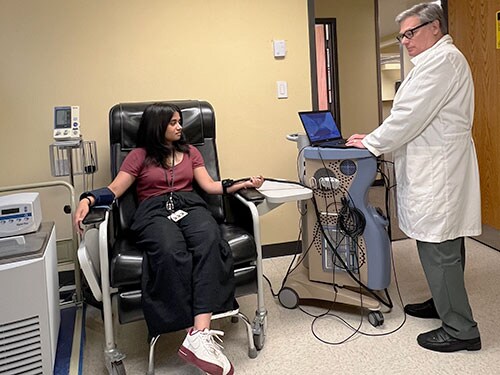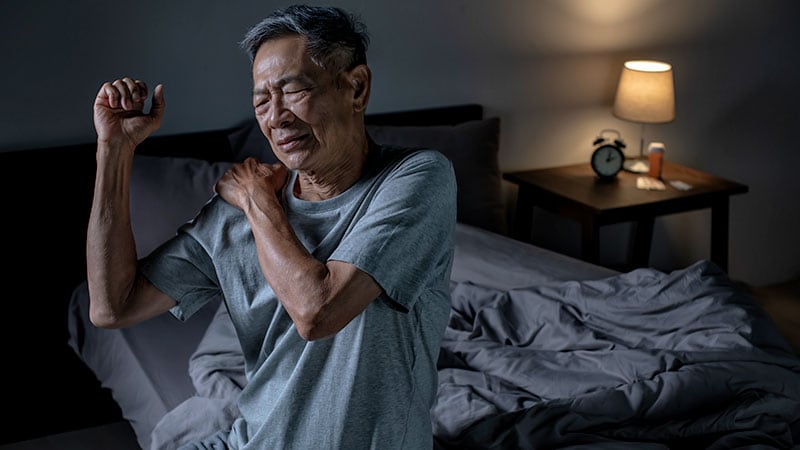Early in his career as a pain researcher, Daniel Whibley, PhD, was struck by an article that drew parallels between methods of torture and the experiences of patients with insomnia and chronic pain.

Dr Daniel Whibley
The author of that article, Nicole Tang, DPhil, observed that two methods used by torturers ― pain infliction and sleep deprivation ― harm people in ways that also are experienced by many patients with pain and sleep conditions.
Patients are “essentially living in this perpetually undesirable, at best, situation where both of these features are playing out in their lives,” said Whibley, a research assistant professor of physical medicine and rehabilitation at the University of Michigan in Ann Arbor.
The problems create a “kind of vicious circle,” he said. Pain disrupts sleep. Insufficient sleep worsens pain.
Studies have established important relationships between the conditions, but investigators are still trying to clarify the mechanisms that connect them and the best ways to intervene to improve patient outcomes.
To that end, Whibley has developed an intervention known as Move & Snooze to benefit patients with pain associated with osteoarthritis.
The program includes remote exercise coaching and an automated 6-week course of digital cognitive-behavioral therapy for insomnia (CBT-I). Whibley’s hypothesis is that addressing sleep disturbances will help patients stay engaged with the physical activity component of the program and help with pain management.
He and his colleagues have tested the intervention in a feasibility study and are in the process of securing grant funding to test it in a large, nationwide trial.
Losing Sleep for Science
Michael Smith, PhD, is examining the sleep-pain connection from a different angle.

Dr Michael Smith
Smith, the director of the Behavioral Medicine Research Laboratory at Johns Hopkins University in Baltimore, is recruiting healthy adults to endure restless nights and painful stimuli.
His team is conducting a study known as Sleep-MOR that aims to reveal how different types of sleep disturbances influence pain and a person’s response to opioids.
Nearly three dozen participants have completed the study so far, Smith said, out of what he hopes will be 200 in all.
Participants are randomly assigned to sleep normally or to undergo an experimental condition that is designed to mimic the sleep disturbances of insomnia or obstructive sleep apnea (OSA).
In a “forced awakening” group, participants are awakened for 20-minute intervals every hour and for a full hour-long window during the night. In this condition, they could sleep for about four hours in all. Forced awakening is intended to represent insomnia
A “sleep fragmentation” group is meant to represent patients with OSA. About 30 times per hour, tones and tactile buzzers rouse sleeping participants without fully waking them up. Although the experiment involves brief arousals such as those experienced by patients with OSA, it does not capture another important feature of sleep apnea ― the cessation of breathing, Smith noted.
The next day, researchers perform pain testing and brain imaging and see how opioid receptors respond to pain medication.
“Some of the forms of sleep loss that we are studying may actually alter the efficacy of the binding of those receptors, and that might then require you to have higher doses of an opioid to get the same effect,” Smith said. “That’s our hypothesis.”
If that bears out, disturbed sleep may play a role in the development of opioid use disorder and have implications for patients who receive opioids after surgery, he said.

Thermal pain sensitivity testing.
In the lab, researchers examine pain thresholds using techniques such as thermal pain testing, in which a thermode attached to a participant’s arm heats up. The temperature “slowly goes up and the patient just says, ‘Ouch,’ when it first hurts. Then we have their pain threshold,” Smith said.
A Bidirectional Relationship
Epidemiologic studies have found that if you follow women who do not have pain, those with complaints about sleep are more than twice as likely to develop fibromyalgia.
Smith’s group and others have shown that if you deprive a healthy person of sleep, they become more sensitive to pain.
Inflammation could be one possible reason for this effect. In one study, participants who experienced forced awakening experienced less slow-wave sleep, which was tied to more inflammation in the morning. Increased inflammation was linked to greater pain sensitivity.
“We are starting to piece together some of the pathways. That’s just one,” Smith said.
A recent study by researchers at Harvard University and elsewhere investigated how sleep disturbances affected three pain pathways. In that study, the results varied by sex. The data indicate that optimal treatment approaches might differ for men and women, the researchers said.
Waking Up to the Problem
Sleep problems can be neglected in medical school and in the clinic. “People just have other things to focus on that they clearly know what they can do about it,” Smith said.
But clinicians should not hesitate to screen for conditions such as insomnia or OSA and refer patients to a specialist. If a patient has had pain for 6 months and treatments are not working, the chance that they have a treatable sleep disorder “is very high, above 50%,” Smith said. Many could have more than one sleep disorder, he added.
Continuous positive airway pressure for OSA and CBT for insomnia can improve sleep. Smith said he expects these measures will improve overall pain management as well.
If treating a sleep disorder fails to help with pain, however, it may still help prevent other sleep-related problems, such as depression, poor glucose control, and heart disease. It also could improve patients’ ability to function day to day, he said.
Evidence on whether treating sleep problems reduces pain has so far been mixed.
“We’ve done some studies showing that if you have CBT-I and you have knee arthritis, improvements in the amount of time you spend awake at night translate into improvements in pain at 6 months. There is a signal there, but it’s not as strong as we would like,” he said. “It may be that it takes longer than anyone would like” to have an effect.
A structured intervention such as CBT-I is likely more beneficial than education about sleep hygiene alone in resolving sleep disturbances, Whibley said. CBT-I includes active components such as sleep restriction therapy and stimulus control therapy and is recommended by the American Academy of Sleep Medicine as the first-line treatment for chronic insomnia.
Patients should consider the role that sleep may play in their chronic pain condition, he said.
“An increasing number of researchers and clinicians are becoming more interested in this as a foundational pillar of health, alongside activity and diet,” Whibley said. “Sleep is recognized as just as important but doesn’t seem to get the airtime.”
Clinicians, he added, should regularly assess their patients’ sleep and know where to refer those whom they feel would benefit from more advanced management: “They [should] know that they have at least got it on their radar to check as one of the important pillars of health that you should be able to control.”
Sleep Trials Seeking Pain Patients
Researchers around the United States are conducting dozens of studies related to sleep and pain. The following trials are recruiting participants, according to ClinicalTrials.gov:
Sleep and Pain Interventions in Women With Fibromyalgia (SPIN-II) . Investigators at the University of Missouri–Columbia are examining two cognitive-behavioral treatments for women with fibromyalgia and insomnia. “This trial will yield important information about the roles of sleep, arousal, and brain structure and function in the development and maintenance of chronic pain in women with fibromyalgia,” the researchers say.
Prospective Randomized Trial of CPAP for SDB in Patients Who Use Opioids (PRESTO) . At the University of California, San Diego, researchers are investigating whether patients with chronic pain who use opioids and have sleep-disordered breathing may benefit from treatment with continuous positive airway pressure (CPAP). They plan to assess the intervention’s effects on sleep quality, pain, and quality of life. They also will see which patients are least likely to benefit from this treatment approach.
Latent Aging Mechanisms in Pain and Sleep (LAMPS) . Researchers at the University of Florida are studying the effects of oral gamma-aminobutyric acid in older adults with chronic pain and sleep difficulties.
Sleep and Pain in Sickle Cell Disease . At Johns Hopkins University, investigators are evaluating how behavioral sleep interventions influence pain and brain function in patients with sickle cell disease.
Pain in Long COVID-19: The Role of Sleep . Researchers at Beth Israel Deaconess Medical Center are conducting an observational study of patients with long COVID who have pain and sleep disturbances. The study aims “to understand the role of sleep in the development and persistence of pain symptoms in long COVID,” they say.
Intervention for Sleep and Pain in Youth: A Randomized Controlled Trial (I-SPY-RCT) . Adolescents with migraine are being recruited by a team at Seattle Children’s Hospital for a randomized controlled trial. The study will examine the effects of CBT-I as well as the combined effect of CBT-I and pain interventions on reducing insomnia symptoms and headache-related disability in this population.
For more news, follow Medscape on Facebook, Twitter, Instagram, and YouTube.
Source: Read Full Article
